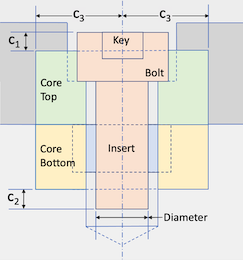








Cubit 16.18 User Documentation
The reduce options provide automatic defeaturing and simplification solutions for specific classes of geometry. These options are most often used as methods for rapidly modifying geometry representing fasteners and springs to representations that can be readily used in analysis. For example, the CAD representation of a bolt may include threads, fillets, chamfers, cavities and may also overlap surrounding geometry. The reduce option can automatically defeature, webcut and modify surrounding geometry as well as mesh and apply boundary conditions according to a designated recipe. A limited number of reduce recipes are currently supported for bolts, including the following:
| Reduce Recipe | Command Syntax | Description | |
| Reduce Bolt (Simplify) | reduce volume <id_list> | Simplify/Defeature bolt geometry only |  |
| Reduce Bolt Fit Volume | reduce volume <id_list> bolt fit_volume | Simplify bolt and fit to surrounding geometry |  |
| Reduce Bolt Core | reduce volume <id_list> bolt core | Simplify bolt and insert surrounding core geometry |  |
| Reduce Bolt Spider | reduce volume <id_list> bolt spider | Remove bolt and replace with spider mesh |  |
| Reduce Bolt Patch | reduce volume <id_list> bolt patch | Remove bolt and replace with a circular sideset patch |  |
| Reduce Spring | reduce volume <id_list> spring | Creates curve(s) following center of spring cross-section |  |
| Reduce Thin Volume | reduce volume <id_list> thin auto | Reduces the thin 3D volumes to a connected set of 2D shell surfaces |  |
| Reduce Thin Volume RL | reduce volume <id_list> thin RL | Uses machine learning and reinforcement learning to reduce thin 3D volumes to a connected set of 2D shell surfaces. See also Beam and Shell Modeling with the Geometry power Tool |  |
| Reduce Slot Surface | reduce surface <id> slot | Provides decomposition solutions for Electromagnetics simulation for decomposing and preparing slot surfaces for analysis. See also Slot Surface Preparation with the Geometry power Tool |  |
The reduce command is often used in conjunction with the Geometry Power tool and the machine learning classification methods. The classification tool can group volumes according to commonly recognized shapes such as bolt, nut, washer, spring, etc.